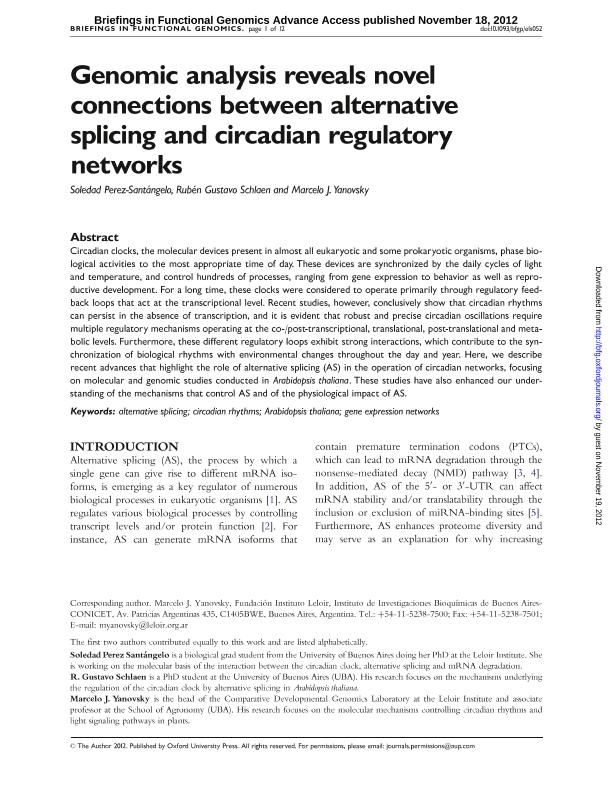Mostrar el registro sencillo del ítem
dc.contributor.author
Perez Santangelo, Maria Soledad

dc.contributor.author
Schlaen, Rubén Gustavo

dc.contributor.author
Yanovsky, Marcelo Javier

dc.date.available
2017-07-06T13:52:41Z
dc.date.issued
2013-01
dc.identifier.citation
Perez Santangelo, Maria Soledad; Schlaen, Rubén Gustavo; Yanovsky, Marcelo Javier; Genomic analysis reveals novel connections between alternative splicing and circadian regulatory networks; Oxford University Press; Briefings in Functional Genomics; 12; 1; 1-2013; 13-24
dc.identifier.issn
2041-2649
dc.identifier.uri
http://hdl.handle.net/11336/19714
dc.description.abstract
Circadian clocks, the molecular devices present in almost all eukaryotic and some prokaryotic organisms, phase biological activities to the most appropriate time of day. These devices are synchronized by the daily cycles of light and temperature, and control hundreds of processes, ranging from gene expression to behavior as well as reproductive development. For a long time, these clocks were considered to operate primarily through regulatory feedback loops that act at the transcriptional level. Recent studies, however, conclusively show that circadian rhythms can persist in the absence of transcription, and it is evident that robust and precise circadian oscillations require multiple regulatory mechanisms operating at the co-/post-transcriptional, translational, post-translational and metabolic levels. Furthermore, these different regulatory loops exhibit strong interactions, which contribute to the synchronization of biological rhythms with environmental changes throughout the day and year. Here, we describe recent advances that highlight the role of alternative splicing (AS) in the operation of circadian networks, focusing on molecular and genomic studies conducted in Arabidopsis thaliana. These studies have also enhanced our understanding of the mechanisms that control AS and of the physiological impact of AS.
dc.format
application/pdf
dc.language.iso
eng
dc.publisher
Oxford University Press

dc.rights
info:eu-repo/semantics/openAccess
dc.rights.uri
https://creativecommons.org/licenses/by-nc-sa/2.5/ar/
dc.subject
Splicing Alternativo
dc.subject
Reloj Biologico
dc.subject
Plantas
dc.subject.classification
Bioquímica y Biología Molecular

dc.subject.classification
Ciencias Biológicas

dc.subject.classification
CIENCIAS NATURALES Y EXACTAS

dc.title
Genomic analysis reveals novel connections between alternative splicing and circadian regulatory networks
dc.type
info:eu-repo/semantics/article
dc.type
info:ar-repo/semantics/artículo
dc.type
info:eu-repo/semantics/publishedVersion
dc.date.updated
2016-09-05T13:18:08Z
dc.identifier.eissn
2041-2657
dc.journal.volume
12
dc.journal.number
1
dc.journal.pagination
13-24
dc.journal.pais
Reino Unido

dc.journal.ciudad
Oxford
dc.description.fil
Fil: Perez Santangelo, Maria Soledad. Consejo Nacional de Investigaciones Científicas y Técnicas. Oficina de Coordinación Administrativa Parque Centenario. Instituto de Investigaciones Bioquímicas de Buenos Aires. Fundación Instituto Leloir. Instituto de Investigaciones Bioquímicas de Buenos Aires; Argentina. Universidad de Buenos Aires; Argentina
dc.description.fil
Fil: Schlaen, Rubén Gustavo. Universidad de Buenos Aires; Argentina. Consejo Nacional de Investigaciones Científicas y Técnicas. Oficina de Coordinación Administrativa Parque Centenario. Instituto de Investigaciones Bioquímicas de Buenos Aires. Fundación Instituto Leloir. Instituto de Investigaciones Bioquímicas de Buenos Aires; Argentina
dc.description.fil
Fil: Yanovsky, Marcelo Javier. Consejo Nacional de Investigaciones Científicas y Técnicas. Oficina de Coordinación Administrativa Parque Centenario. Instituto de Investigaciones Bioquímicas de Buenos Aires. Fundación Instituto Leloir. Instituto de Investigaciones Bioquímicas de Buenos Aires; Argentina. Universidad de Buenos Aires. Facultad de Agronomia; Argentina
dc.journal.title
Briefings in Functional Genomics
dc.relation.alternativeid
info:eu-repo/semantics/altIdentifier/url/https://academic.oup.com/bfg/article-lookup/doi/10.1093/bfgp/els052
dc.relation.alternativeid
info:eu-repo/semantics/altIdentifier/doi/https://doi.org/10.1093/bfgp/els052
Archivos asociados
